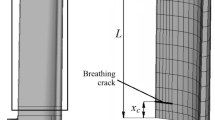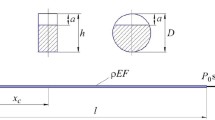The results of computational experiments to determine the influence of the width and location of a groove as a model of open edge crack on the formation of the spectrum of natural frequencies of torsional vibrations of cantilever rods are presented. The modal characteristics of rods with geometrical parameters corresponding to a wide slenderness range of turbomachine rotor blades are considered. A modal analysis of rods with local material discontinuity in the form of a groove was carried out by means of three-dimensional finite element modeling. Based on the results of computational studies, the dependence of the change in the natural frequency of the 1st–4th torsional vibration modes on the location and depth of a 1 mm wide groove was determined. It is shown that under torsional vibrations at a certain location of the damage, the natural frequency of the rod is equal to the frequency without it. It was established that this relative location, called the transition point, is inherent in all modes of torsional vibrations of the objects under study. A characteristic feature is that the transition point depends on the depth of damage and the radius of inertia of the rod cross-section and does not depend on the rod length. It is shown that, in addition to the presence of a transition point, the obtained plots for the 2nd–4th modes of torsional vibrations are characterized by the presence of ranges of the relative location of the groove, at which there is exceeding the value of the vibration frequency of the undamaged rod which is caused by the ratio of its elastic and inertial properties. A comparative analysis of the laws governing the formation of the spectra of natural frequencies of torsional and bending vibrations of the rods under study in the fundamental mode and higher modes was carried out. These plots can be used to select a method for the vibration diagnostics of highly stressed parts of modern machines, in particular, turbomachine blades.






Similar content being viewed by others
References
R. D. Adams, P. Cawley, C. J. Pye, and B. J. Stone, “A vibration technique for non-destructively assessing the integrity of structures,” J Mech Eng Sci, 20, No. 2, 93–100 (1978).
W. M. Ostachowich and M. Krawczuk, “Analysis of the effect of cracks on the natural frequencies of a cantilever beam,” J Sound Vib, 150, No. 2, 191–201 (1991).
Y. S. Lee and M. J. Chung, “A study on crack detection using eigenfrequency test data,” Comput Struct, 77, 327–342 (2000).
M. Attar, “A transfer matrix method for free vibration analysis and crack identification of stepped beams with multiple edge cracks and different boundary conditions,” Int J Mech Sci, 57, 19–33 (2012).
D. K. Agarwallaa and D. R. Parhi, “Effect of crack on modal parameters of a cantilever beam subjected to vibration,” Procedia Engineer, 51, 665–669 (2013).
K. H. Barad, D. S. Sharma, and V. Vyas, “Crack detection in cantilever beam by frequency-based method,” Procedia Engineer, 51, 770–775 (2013).
K. Savchenko, A. Zinkovskii, Ye. Onyshchenko, et al., “Diagnostics of the presence of a fatigue crack in the compressor blade using the spectrum of vibration amplitudes at the superharmonic resonance,” Bulletin of the National Technical University “KhPI” Ser. Dynamics and Strength of Machines, 2, 50–54 (2021).
E. O. Onyshchenko, A. P. Zinkovskii, and V. V. Matveev, “Determination of the effect of a mode I surface crack cross-sectional shape on the characteristics of the forced bending vibrations of a cantilever beam,” Strength Mater, 54, No. 2, 178–187 (2022). https://doi.org/10.1007/s11223-022-00393-4
V. V. Matveev, E. O. Onishchenko, O. L. Derkach, and O. E. Boginich, “Vibrodiagnostics of the presence of surface symmetrical cracks in beams of rectangular and round cross-sections by the characteristics of their nonlinear longitudinal vibrations,” Strength Mater, 54, No. 5, 785–801 (2022). https://doi.org/10.1007/s11223-022-00455-7
A. P. Zinkovskii, I. G. Tokar’, and V. A. Kruts, “Influence of the local surface damage parameters on the natural frequencies of vibration of structural elements,” Strength Mater, 47, No. 2, 221–226 (2015). https://doi.org/10.1007/s11223-015-9651-1
A. P. Zinkovskii and I. G. Tokar’, “Influence of local surface damage on the natural frequencies of the higher modes of flexural vibration of cantilever rods,” Strength Mater, 50, No. 4, 557–564 (2018). https://doi.org/10.1007/s11223-018-0001-y
K. Wang, D. J. Inman, and C. R. Farrar, “Modeling and analysis of a cracked composite cantilever beam vibrating in coupled bending and torsion,” J Sound Vib, 284, 23–49 (2005).
A. R. Daneshmehr, A. Nateghi, and D. J. Inman, “Free vibration analysis of cracked composite beams subjected to coupled bending-torsion loads based on a first order shear deformation theory,” Appl Math Model, 37, No. 24, 10074–10091 (2013).
O. L. Derkach, A. P. Zinkovskii, Ye. O. Onyshchenko, and K. V. Savchenko, “Notch-type damage influence on the frequency of the principal mode of the composite cantilever beam flexural vibrations,” Procedia Struct Int, 36, 71–78 (2022).
Author information
Authors and Affiliations
Corresponding author
Additional information
Translated from Problemy Mitsnosti, No. 4, pp. 56 – 65, July – August, 2023.
Rights and permissions
Springer Nature or its licensor (e.g. a society or other partner) holds exclusive rights to this article under a publishing agreement with the author(s) or other rightsholder(s); author self-archiving of the accepted manuscript version of this article is solely governed by the terms of such publishing agreement and applicable law.
About this article
Cite this article
Tokar, I.G., Derkach, O.L., Kabannyk, S.M. et al. Study of the Influence of the Presence of Local Edge Damage on the Spectrum of Natural Frequencies of Torsional Vibrations of Cantilever Rods. Strength Mater 55, 727–735 (2023). https://doi.org/10.1007/s11223-023-00562-z
Received:
Published:
Issue Date:
DOI: https://doi.org/10.1007/s11223-023-00562-z




